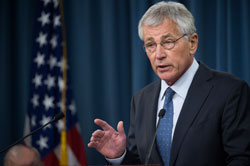A new development in the tensions between the United States and China came to light this week when a Chinese high altitude spy balloon was spotted over Billings, Montana.
The Pentagon presumes the balloon initially flew over the Aleutian Islands, across Canada, and then made its way into Montana. The Pentagon has deemed the incident a major security invasion, whereas China has claimed that the balloon was merely a “civilian unmanned airship” with the purpose of conducting weather research before being blown off course and ending up in American territorial airspace. It has since been confirmed that a second balloon was also detected flying over Latin America, with China giving the same explanation as the first incident.
Speculation arose across the nation as to how President Joe Biden should address this security concern.
Specifically, there have been questions as to whether or not the balloon should be shot down right away. Many Americans felt it was dire to get it out of the American airspace as soon as possible, whereas others questioned what could take place following its removal.
On Wednesday, Biden directed military leaders to shoot the balloon down when they deemed it would be safest for individuals and their property on the ground beneath it. This decision was made to combat the surveillance threat that was posed to the United States military, as well as to prevent the potential surveillance device from collecting any private intelligence.
The United States Department of Defense explained that “Military commanders determined that there was undue risk of debris causing harm to civilians while the balloon was over land.” This led military agents to take down the balloon once it had floated over U.S. waters.
The balloon was shot down by a U.S. Air Force F22 over the Atlantic Ocean at 2:39 p.m. on Saturday, Feb. 4, just off of the coast of South Carolina. In less than a week, the surveillance balloon had traveled across the country and reached the East Coast.
The downing of the balloon is also the first confirmed downing of an aircraft by an F22 and one of the highest altitude downing of an aircraft in history.
The Defense Department further assured that this was the first opportunity that the United States had to bring down the balloon that would not pose a threat to anyone’s safety, and also clarified that “there are no indications that any people, including U.S. military personnel, civilian aircraft, or maritime vessels were harmed in any way” as a result of removing the balloon from the sky.
It was recently revealed that this was not the first incident of Chinese balloons violating US airspace.
Numerous incidents were kept secret during the Trump Administration, with noted incidents near Hawaii and Florida.
This situation has shed light on the rising tensions between the United States and China, two of the world’s most powerful nations.
In 2007, China announced a $45 billion increase in military spending, and in 2008 China became the largest holder of United States foreign debt.
Since then, a number of scenarios have arisen between the two countries, including a United States court indicting five Chinese hackers, and China removing itself from the U.S.-China cybersecurity working group as a result.
Further building tensions between the two nations, a trade war began in the early 2010s, with the United States trade deficit reaching $295.5 billion in 2011.
Then, in 2018, the Trump Administration announced a number of tariffs totaling nearly $50 billion, which, according to the Council of Foreign Relations, was in response to “Chinese theft of U.S. technology and intellectual property.” Later in the year, more tariffs were announced, as well as the administration condemning what they felt was growing military aggression.
Tensions seemed to reach their peak in 2020 amid the COVID pandemic, with the first case being reported out of Wuhan, China. Global panic ensued and further strained the relationship between the two nations.
Additionally, on the last day of Donald Trump’s presidency, U.S. Secretary of State Mike Pompeo declared China’s actions against Uyghurs, a Muslim ethnic group residing in China, as crimes against humanity and genocide. This declaration was also agreed upon once the Biden administration took over office, and by the end of 2021, imports out of Xinjiang were banned.
Nashaviah Steward, a senior political science student, described the potential for future tensions between the U.S. and China: “I think that this balloon situation is an indicator of a much larger issue between the U.S. and China. Instead of receiving reassurance from the government that relations between the two nations are fine, this was one of the first times in recent years that the public gained insight into truly how tense the conditions are. The public also witnessed one of the first performances of fear from the U.S. government that it’s seen in a very long time.”
Another junior political science student added, “While I am uncertain as to what this means for the future of relations between the United States and China, I do see this clear violation as extremely alarming. I don’t think that this surveillance balloon accidentally made its way into our airspace, and I’m not sure what its intended purpose of being here was. Either way, I think that tensions are definitely escalating between us and China right now, and that can be alarming for many Americans to think about.”


